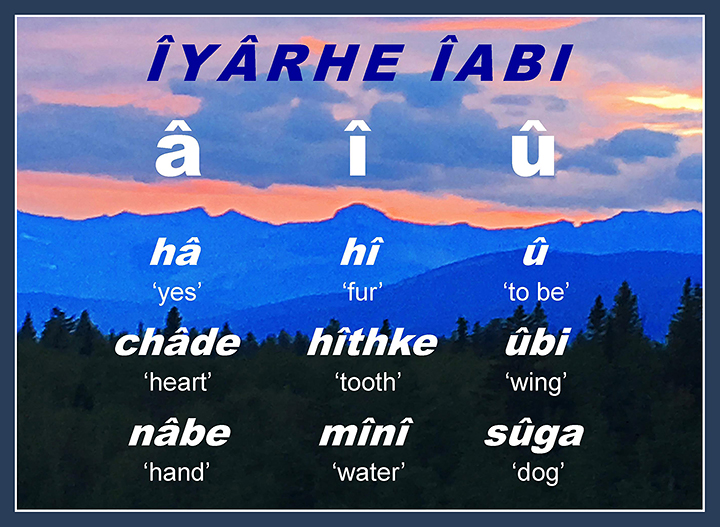
Stoney Nakoda writing system offers mountaintop experienceCOFFEE WITH WARREN, with Warren Harbeck |

|
The diacritic over Stoney Nakoda nasal vowels could be viewed as “little mountains.” Photo by Terry Poucette, graphic by Warren Harbeck A photo Terry Poucette took the other day from her Morley residence has inspired a whole new way of looking at a detail in the writing system for her Stoney Nakoda language, and it’s a real mountaintop moment. You’ll recall that in last week’s column I quoted the University of Victoria assistant professor – and daughter of respected Stoney Nakoda Elder Tina Fox – on language and identity. “My language helps me to feel like I belong somewhere,” Terry said. Back here in the Bow Valley, Terry was enjoying the sunset mountain vista from her window and took the accompanying photo. As I was reflecting on its beauty, the scene whispered to me to don my linguistic thinking cap. I did, and suddenly I understood a new way of referring to the nasalization mark that appears over three of the vowels in the official Stoney Nakoda writing system: â, î and û, and it all relates to one of the ways the Stoney Nakoda people refer to themselves. Folks at Morley have long identified themselves as Îyethka, Nakoda or Îyethka Nakoda, all related to their Dakota/Lakota/Nakota (Nakoda) Sioux heritage. There’s another name that’s also becoming popular: Îyârhe Nakoda, “Rocky Mountain Nakoda.” Rocky Mountain? Of course! That feature so important in the Stoney Nakoda landscape is also a great way to refer to an alphabetic feature so important in their language: the nasalization mark. The rafter-shaped diacritic is technically called a circumflex. But why not refer to it as an îyârhenâ, a “little mountain”? If nasalization is a feature of the Îyârhe Nakoda language, then why couldn’t this mark be thought of as a beautiful symbol of Îyârhe îabi, “Mountain Speak”? The contrast between oral and nasal vowels is not important in English. But in Stoney Nakoda, nasal vowels are totally separate sounds from oral vowels. In fact, it makes a big difference in whether someone says ha or hâ – the first meaning “skin” and the second meaning “yes.” Likewise, it makes a big difference in whether someone says hi or hî, “blade of a knife” or “fur”; and whether someone says u or û, “to come” or “to be.” (Remember, in Stoney Nakoda, unlike English, each letter of the alphabet stands for only one sound. Thus, Stoney Nakoda a is always similar to the sound of the English vowel in the first syllable of “father”; that Stoney Nakoda i is similar to the sound of the English vowel in the word “ski”; and that Stoney Nakoda u is similar to the sound of the English vowel in the word “flute.”) So, folks, just as the mountaintops to the west provide a beautiful cap over the landscape, so the îyârhenâ provides a beautiful cap over Stoney Nakoda nasal vowels. Thank you, Terry, for this mountaintop inspiration.
© 2018 Warren Harbeck |